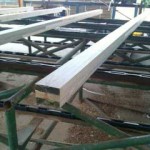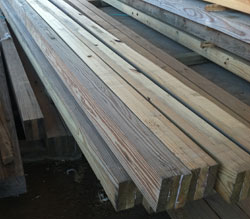Post Frame and Glulaminated Columns
When it comes to using glulaminated columns in post frame buildings, most envision ones where lower portions (usually six to 10 feet) are pressure preservative treated and upper remain untreated. Most of these are products of highly graded Southern Pine and/or MSR (Machine Stress Rated) or MEL (Machine Evaluated Lumber).
 For columns to be mounted into ICC-ESR Code conforming wet-set brackets there are other alternatives. Standard glulams for construction typically have a Fb (fiberstress in bending) of 2400 pounds per inch. This compares favorably to familiar pressure treated lower glulams, where most have a Fb rating of roughly 1900.
For columns to be mounted into ICC-ESR Code conforming wet-set brackets there are other alternatives. Standard glulams for construction typically have a Fb (fiberstress in bending) of 2400 pounds per inch. This compares favorably to familiar pressure treated lower glulams, where most have a Fb rating of roughly 1900.
There are four basic appearance classifications for glulam beams as defined in APA-EWS Form No. EWSY110 and ANSI A 190.1 (although in ANSI A190.1 they are referred to as glulam appearance “grades”). Classifications are as follows: Framing, Industrial, Architectural and Premium. These classifications are summarized below and relate to a glulam beams’ appearance only, not to its strength.
Framing Appearance
This classification is provided to match standard dimensional lumber widths (typically 3-1/2” and 5-1/2” widths). Glulam members will be planed in a “Hit and Miss” fashion. Low laminations, glue smear and glueline squeezeout are permitted. Knot holes, splits and wane are also permitted and will not be filled.
Industrial Appearance
This classification should be used (specified) when appearance is not of primary concern. Loose knots and knot holes appearing on the wide face of laminations (beam bottom) exposed to view will be filled with putty, but voids appearing on lamination edges will not. Occasional misses, low laminations or wane are permitted.
Architectural Appearance
This is a high quality appearance suitable for applications where appearance is important but not an overriding consideration. All exposed knot holes and voids measuring over ¾” will be filled with a wood-tone filler. Exposed surfaces will be smooth and bottom corners (edges) will be eased.
Premium Appearance
This is the highest standard glulam appearance classification. All exposed knot holes and voids will be filled with a wood-tone filler. Exposed surfaces will be smooth and bottom corners will be eased.
For post frame columns above grade, framing or industrial appearance glulams will be most cost effective. Wanting to create some spectacular beamed ceilings or open trusses? If so, architectural or premium appearance might just be your ticket.
Tag Archives: fiberstress in bending
NDS Size Factor (Cf) for Lumber
Continuing explaining terms used in a decade old article of mine (https://www.hansenpolebuildings.com/2014/08/lumber-bending/) is Cf (size factor, also known as width adjustment factor).
NDS (National Design Standards)design values for SYP (Southern Yellow Pine) are specified by size due to actual, physical in grade testing, whereas other lumber species’ design values have a base value adjusted by width of member.
Prior to 1957 no size adjustment equations for deep bending members were given in the NDS, only other publications were referenced based upon tests of bending members up to 12 inches deep. From 1957 to 1968 specifications included an adjustment factor for deep bending members.
 Back in the day, most engineers specified a minimum lumber grade on their plans (such as Douglas Fir #1 or better) and didn’t go much further. Then someone mentioned glu-laminated timber industry was using a volume factor to modify a member’s section modulus (S or Sm) indirectly influencing stress carrying capacities. It was wondered if sawn lumber should have a similar factor, resulting in actual in grade physical testing.
Back in the day, most engineers specified a minimum lumber grade on their plans (such as Douglas Fir #1 or better) and didn’t go much further. Then someone mentioned glu-laminated timber industry was using a volume factor to modify a member’s section modulus (S or Sm) indirectly influencing stress carrying capacities. It was wondered if sawn lumber should have a similar factor, resulting in actual in grade physical testing.
It was found smaller members failed (broke) at higher stress levels than deeper members. Applying statistical analysis methods a percentage factor (Cf) was to be applied to 2x and 4x members between four and 16 inch depths.
The intent was for engineers to be able to account for this stress skew in their calculations, without having to specify on their plans grade of every size member being used.
For two inch thick lumber, visually graded as #3, #2, #1, #1 and better or Select Structural. Fb (fiberstress in bending) value was assigned a Cf of 1.0 (or no adjustment). 2×2 through 2×4 Cf = 1.5, 2×5 = 1.4, 2×6 = 1.3, 2×8 = 1.2, 2×10 = 1.1 and 2×14 and wider = 0.9. These values, as well as adjustment factors for Ft (fiberstress in tension) and Fc (fibrstress in compression) can be found in the NDS.
Post Frame and Glulaminated Columns
When it comes to using glulaminated columns in post frame buildings, most envision ones where lower portions (usually six to 10 feet) are pressure preservative treated and upper remain untreated. Most of these are products of highly graded Southern Pine and/or MSR (Machine Stress Rated) or MEL (Machine Evaluated Lumber).
 For columns to be mounted into ICC-ESR Code conforming wet-set brackets there are other alternatives. Standard glulams for construction typically have a Fb (fiberstress in bending) of 2400 pounds per inch. This compares favorably to familiar pressure treated lower glulams, where most have a Fb rating of roughly 1900.
For columns to be mounted into ICC-ESR Code conforming wet-set brackets there are other alternatives. Standard glulams for construction typically have a Fb (fiberstress in bending) of 2400 pounds per inch. This compares favorably to familiar pressure treated lower glulams, where most have a Fb rating of roughly 1900.
There are four basic appearance classifications for glulam beams as defined in APA-EWS Form No. EWSY110 and ANSI A 190.1 (although in ANSI A190.1 they are referred to as glulam appearance “grades”). Classifications are as follows: Framing, Industrial, Architectural and Premium. These classifications are summarized below and relate to a glulam beams’ appearance only, not to its strength.
Framing Appearance
This classification is provided to match standard dimensional lumber widths (typically 3-1/2” and 5-1/2” widths). Glulam members will be planed in a “Hit and Miss” fashion. Low laminations, glue smear and glueline squeezeout are permitted. Knot holes, splits and wane are also permitted and will not be filled.
Industrial Appearance
This classification should be used (specified) when appearance is not of primary concern. Loose knots and knot holes appearing on the wide face of laminations (beam bottom) exposed to view will be filled with putty, but voids appearing on lamination edges will not. Occasional misses, low laminations or wane are permitted.
Architectural Appearance
This is a high quality appearance suitable for applications where appearance is important but not an overriding consideration. All exposed knot holes and voids measuring over ¾” will be filled with a wood-tone filler. Exposed surfaces will be smooth and bottom corners (edges) will be eased.
Premium Appearance
This is the highest standard glulam appearance classification. All exposed knot holes and voids will be filled with a wood-tone filler. Exposed surfaces will be smooth and bottom corners will be eased.
For post frame columns above grade, framing or industrial appearance glulams will be most cost effective. Wanting to create some spectacular beamed ceilings or open trusses? If so, architectural or premium appearance might just be your ticket.






